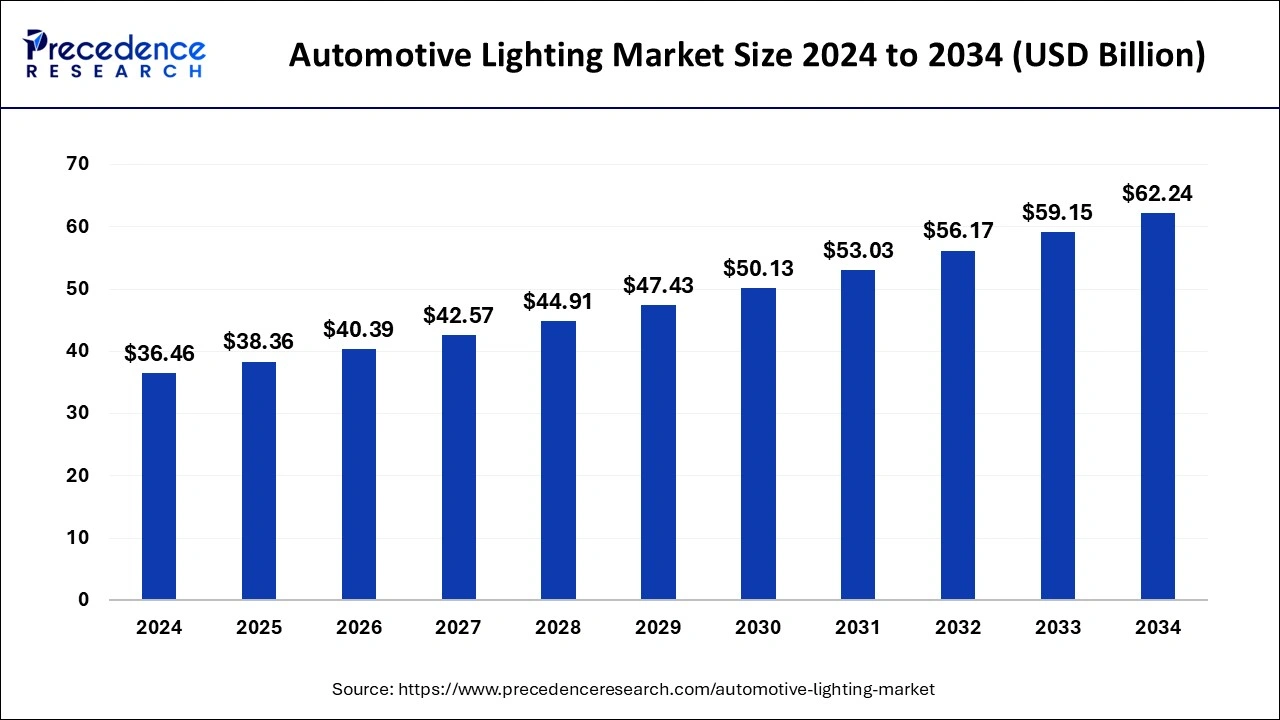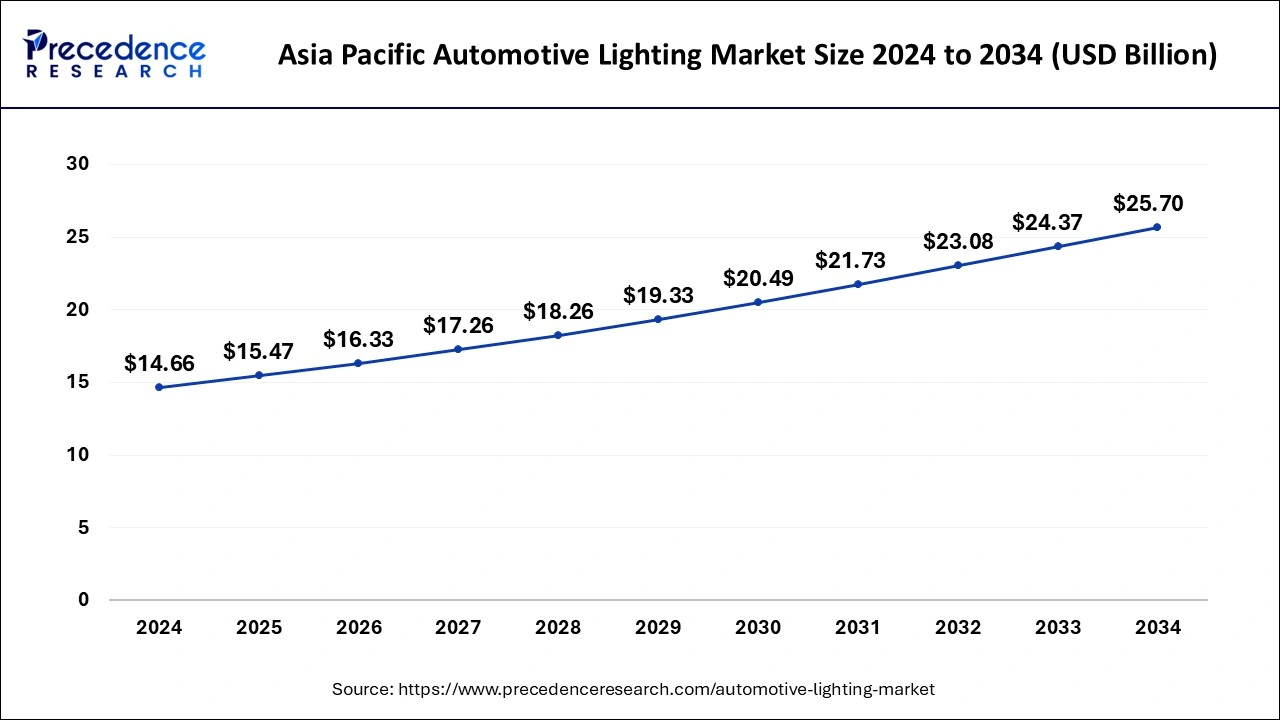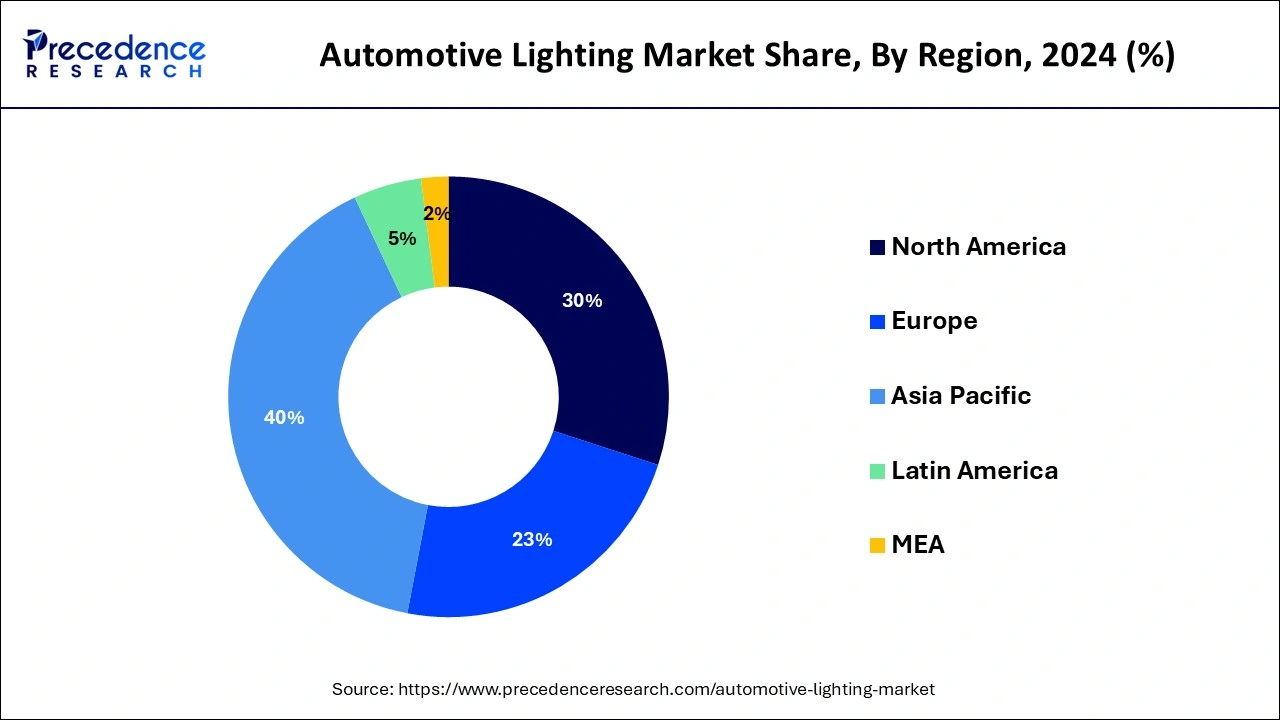List of Contents
What is the Automotive Lighting Market Size?
The global automotive lighting market size is calculated at USD 38.36 billion in 2025 and is predicted to increase from USD 40.39 billion in 2026 to approximately USD 62.24 billion by 2034, expanding at a CAGR of 5.49% from 2025 to 2034. The rising sales of automobiles worldwide is directly increasing the demand for automotive lighting market

Key Takeaways
- Asia Pacific led the market with the biggest market share of 40.11% in 2024.
- By Technology, the halogen segment registered the maximum market share in 2024.
- By Technology, the Light Emitting Diode (LED) segment is expected to expand at the fastest CAGR over the projected period.
- By Application, the front/headlamps segment is expected to expand at the fastest CAGR over the projected period.
Adoption of AI into Automotive Lighting Market
Automobile industry is already embracing Artificial Intelligence (AI) in different processes of end product as well as manufacturing. Adopting AI in the automotive lighting industry will help further expand the market. It can be utilized in automotive exterior lighting by using AI and machine learning (ML) algorithms in combination with sensors. This can identify objects to adjust vehicle lighting improving visibility and safety of the driver. Intelligent interior lightening along with AI technology is extremely beneficial. For instance, gesture control of ambient light, an AI-driven feature, for individual lightning can add comfort for the car interior. AI technology integrated with Internet of Things (IoT) will enhance smart features of the car like location tracking, weather, real-time analysis etc. that helps the driver make informed decisions. AI is set to revolutionize the automotive lighting market in the forecast period.
Market Outlook
- Industry Growth Overview: The automotive lighting market is growing rapidly from 2025 to 2034 due to rising vehicle production, the adoption of LED and adaptive lighting technologies, enhanced safety regulations, and demand for energy-efficient, stylish illumination in both passenger and commercial vehicles.
- Global Expansion: The market is expanding worldwide, driven by rapid vehicle electrification, rising premium car sales, continuous advancements in LED, laser, and smart lighting systems, and stricter safety norms, along with rising consumer preference for enhanced visibility and aesthetics. Emerging regions offer immense opportunities for market expansion due to the rapid expansion of the automotive sector.
- Major Investors: Major investors in the market include global automotive components suppliers and manufacturers and private equity firms. Leading companies such as Osram, Valeo, Hella, Koito Manufacturing, and Stanley Electric invest heavily in R&D, advanced lighting technologies, and global production expansion.
- Startup Ecosystem: The startup ecosystem in the market is rapidly evolving, with new companies focusing on developing innovative LED, lasers, and smart lighting solutions. Startups are creating adaptive, energy-efficient, and connected lighting systems, often integrating sensors and IoT technology to improve vehicle safety, driver assistance, and visual appeal. Many emerging players work with OEMs and tech firms to accelerate adoption and develop niche solutions for electric and autonomous vehicles.
Automotive Lighting Market Growth Factors
Increasing sales and production of automotive vehicle across the world expected to drive the demand for automotive lighting during the forecast period. Rising disposable income, rising need for transportation services, and improvement in lifestyle are the major factors that boost the production of automotive vehicle, thereby propelling the growth of automotive lighting. Furthermore, government regulation for automotive lighting along with rising concern for road safety are some of the prime factors that drive the automotive lighting market growth. Increased number of road accidents is the major cause to propel the demand for adaptive lighting system along with safety features in the automobile. Vehicles with advanced and adaptive lighting can detect objects on road; this prevents the upcoming accident by alerting the driver in proper time to take necessary action. Furthermore, rising demand for vehicle as well as driver safety as a concern regarding increasing accident cases eventually leads to the deployment of efficient lighting systems that provides optimum illumination on road.
Market Scope
| Report Highlights | Details |
| Market Size in 2025 | USD 38.36 Billion |
| Market Size in 2026 | USD 40.39 billion |
| Market Size by 2034 | USD 62.24 Billion |
| Market Growth Rate from 2025 to 2034 | CAGR of 5.49% |
| Largest Market | Asia Pacific |
| Fastest Growing Market | North America |
| Base Year | 2024 |
| Forecast Period | 2025 to 2034 |
| Segments Covered | Technology, Product, Vehicle, Application, and Region |
| Regions Covered | North America, Europe, Asia-Pacific, Latin America and Middle East & Africa |
Segment Insights
Technology Insights
In 2024, halogen technology led the global automotive lighting market with prominent revenue share and expected to register stagnant growth over the forecast period. Easy availability along with less replacement & purchasing cost of the halogen lights are few factors that drive the growth of the segment. They are easily available at low cost and in different dimensions that make them a preferred choice for the consumers. Besides this, excessive heat loss during light radiation restricts the usage of halogen.
As a counterpart, Light Emitting Diode (LED) technology registers lucrative growth over the forecast period. This is primarily attributed to its diverse applications such as brake lights and indicators. Furthermore, their benefits such as energy saving and optimum as well as constant illumination contribute as the other major factors to drive their adoption in automotive lighting industry. Presently, LEDs have penetrated in almost every automotive lighting application along with headlamp sector.
Application Insights
The front/headlamps application segment estimated to register significant growth prospect over the forecast period. This is mainly attributed to the rising advancement in the headlamps along with incorporation LED technology in the front view lighting sector. In electric or battery-powered vehicles energy saving is a prominent aspect and implementation of LED fulfills the requirement for energy saving, thus flourishing demand for electric cars or vehicles expected to drive the growth for LED demand in headlamps segment. Further, adaptive lighting are the most demanded safety features in the advanced vehicles to enhance the driver's visibility also in low lighting condition.
Rear lights are the lighting solution mounted on the back side of the vehicle that comprises indicators, tail lights, brake, and back-up lights. These lights are the most important lighting system that indicates or alerts other drivers on road about the vehicle position, direction, and movement. Presently, halogen lighting is commonly used lighting technology for rear lights in a vehicle; however, LEDs are expected to emerge as the prominent solution in vehicles during analysis period.
Regional Insights
Asia Pacific Automotive Lighting Market Size and Growth 2025 to 2034
The Asia Pacific automotive lighting market size is exhibited at USD 15.47 billion in 2025 and is projected to be worth around USD 25.70 billion by 2034, growing at a CAGR of 5.77% from 2025 to 2034.

The Asia Pacific emerged as the most promising region in the global automotive lighting market with a significant revenue share of nearly 40.11% in 2024 and anticipated to witness the fastest growth over the analysis period. This is primarily due to the high production and sales of passenger vehicles in the region. Increasing purchasing power of the consumers along with rising GDP in the emerging economies attributed to the significant demand for passenger vehicle sales in the region. Further, China, India, Japan, and Taiwan are the major automotive manufacturing hub, thereby fuelling the growth of automotive lights production in the region. In addition, rising number of road accidents in the region are likely to boost the aftermarket sales of automotive lighting. Automotive lighting cover or mirror are the most critical part and easily break while collision, thus automotive lighting is one of the most replaceable part of the automotive vehicle.
India Automotive Lighting Market Trends
Countries like India have a major role to play in the ever-evolving automobile industry for the Asia Pacific region. The country is an important market for the automobile industry which will directly help in increasing the demand for automotive lighting market. The LED segment is gaining momentum in the country as there is a noticeable shift towards advanced technologies. Halogen and LED technologies are growing in demand that will help the market growth in the forecast period.

The U.S. holds the major share of the automotive lighting market in the region. The growing demand from consumers for efficient and advanced technology integrated automobiles are driving the market in the country. The shift of customers to focus on aesthetics, comfort and safety is increasing demand for LED lighting as it an energy efficient option.
What Makes North America the Fastest-Growing Region in the Automotive Lighting Market?
North America is the fastest-growing region in the market due to the increasing demand for advanced lighting technologies, such as LED, adaptive, and intelligent lighting systems, driven by stringent safety regulations and rising consumer preference for premium, tech-equipped vehicles. The rapid adoption of electric vehicles (EVs) and advanced driver-assistance systems (ADAS) is further accelerating the need for sophisticated automotive lighting solutions. Additionally, a strong automotive manufacturing base, high aftermarket retrofit activity, and fleet modernization initiatives contribute to sustained market growth in the region.
How Big is the Success of Europe in the Market?
Europe is expected to grow at a notable rate in the automotive lighting market due to stringent vehicle safety regulations, high adoption of advanced LED and adaptive lighting technologies, and rising sales of premium and electric vehicles. The presence of leading automotive lighting manufacturers investing in innovation and sustainable solutions also drives market growth in the region. Germany is a major contributor to the European market, thanks to its dominant automotive manufacturing industry and concentration of premium vehicle OEMs.
How Crucial is the Role of Latin America in the Automotive Lighting Market?
Latin America plays a significant role in the global market. Its importance stems from rising vehicle production, increasing demand for modern lighting technologies, and expanding urbanization. While the region lags behind Europe and North America in technology adoption, it offers significant opportunities for manufacturers and investors, driven by growing automotive sales, an emerging OEM presence, and a shift toward LED and energy-efficient lighting solutions.
How Big is the Opportunity for the Market in the Middle East & Africa?
The Middle East & Africa present significant growth opportunities in the market due to rising vehicle production, increasing demand for energy-efficient LED and adaptive lighting, and expanding production of luxury and commercial vehicles. Infrastructure development, urbanization, and government initiatives promoting road safety further drive adoption, while growing partnerships with global lighting manufacturers contribute to regional market growth.
The UAE is the dominant country in the Middle East & African market due to its advanced automotive sector, high demand for luxury and commercial vehicles, and early adoption of LED and smart lighting technologies. Strong infrastructure, supportive government policies, and partnerships with global lighting manufacturers further reinforce the UAE's leadership in the regional market.
Value Chain Analysis
1.Raw Material Sourcing
This stage involves procuring high-quality optical-grade plastics, glass, and metal alloys required for automotive lighting components. Sourcing LED chips, semiconductors, and electronic components to ensure efficient and durable lighting systems.
- Key Players: BASF, Osram Semiconductor, TE Connectivity
2.Component Manufacturing
This stage involves fabricating LED modules, lenses, reflectors, and housings with precision engineering to meet automotive safety standards. Assembling adaptive lighting systems, headlamps, tail lamps, and interior illumination units for passenger and commercial vehicles.
- Key Players: Valeo, Hella, Koito Manufacturing
3.Aftermarket Services and Spare Parts
This stage involves providing replacement headlamps, tail lamps, and LED modules to dealerships and service centers for vehicle maintenance. Offering technical support, repair, and refurbishment services to extend lighting system life and maintain performance. Distributing spare parts through global supply chains, ensuring availability for both new vehicles and older models.
- Key Players: Philips Automotive Lighting, Stanley Electric, Magneti Marelli
Automotive Lighting Market Companies
- Osram: A global leader in automotive lighting, offering LED, laser, and OLED lighting solutions for headlamps, tail lamps, and interior illumination, with a focus on energy efficiency, advanced optics, and intelligent lighting systems.
- Valeo: Provides comprehensive automotive lighting systems including adaptive LED headlights, laser lighting, daytime running lights, and interior lighting solutions, with strong R&D in smart and connected vehicle technologies.
- Hella: Specializes in headlamps, rear lamps, and electronic control units for automotive lighting, emphasizing adaptive, high-performance, and safety-compliant lighting solutions for both passenger and commercial vehicles.
- Koito Manufacturing: Offers a wide range of automotive lighting products, including LED headlamps, daytime running lights, and adaptive front-lighting systems, with a focus on innovation, durability, and OEM partnerships.
- Philips Automotive Lighting: Provides halogen, LED, and xenon lighting products for headlamps, tail lamps, and interior lighting, including aftermarket solutions and performance-enhancing lighting technologies.
- Stanley Electric: Delivers LED, halogen, and xenon automotive lighting solutions with emphasis on reliability, advanced optics, and energy efficiency for both OEMs and aftermarket applications.
- Magneti Marelli: Offers automotive exterior and interior lighting systems, including LED, adaptive, and decorative lighting, with strong capabilities in electronics integration and vehicle-specific customization.
Other Major Players
- DENSO Corporation
- Hyundai Mobis
- Koninklijke Philips N.V.
- ROBERT BOSCH GmbH
- ZizalaLichtsysteme GmbH
Recent Developments
- In June 2024, Melexis launched their MLX81123 IC. This will extend their LIN RGB family that offers small SOIC8 and DFN-8 3mm x 3mm package. The miniaturization of this LED drive will offer ambient lighting in different locations inside the vehicle.
- In March 2024, Marelli, a well-known supplier of automotive developed a unique automotive lighting domain control unit platform in China. This platform is designed in a particular way to help manage the front lights and rear lights as well as introduced 360° lighting features in a vehicle.
- In April 2023, Continental AG introduced their automotive lighting product called NightViu, especially designed for construction and off-road vehicles. The company launched a portfolio of 16 products under the product line of NightViu; designed to suit specific requirements for construction, mining, and off-road equipment applications.
Segments Covered in the Report
By Technology
- LED
- Halogen
- Xenon/HID
By Product Sale
- Aftermarket Products
- Original Equipment Manufacturers (OEMs)
By Vehicle Type
- ICE
- Commercial Vehicle
- Passenger Vehicle
- Electric Vehicle
- Hybrid Electric Vehicle (HEV)
- Battery Electric Vehicle (BEV)
- Plug-in Hybrid Electric Vehicle (PHEV)
By Application
- Front/Headlamps
- Side
- Rear Lighting
- Interior Lighting
By Geography
- North America
- Europe
- Asia Pacific
- Latin America
- Middle East and Africa
For inquiries regarding discounts, bulk purchases, or customization requests, please contact us at sales@precedenceresearch.com
Frequently Asked Questions
Ask For Sample
No cookie-cutter, only authentic analysis – take the 1st step to become a Precedence Research client